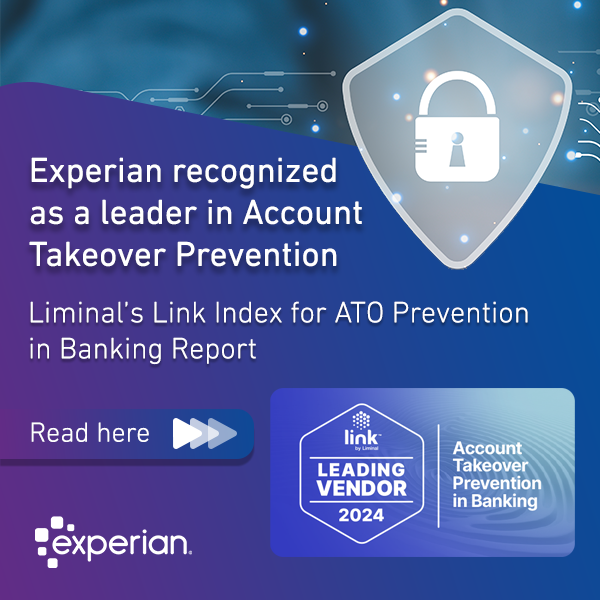Monthly Archives: August 2020

As businesses continue to figure out the best way to operate through the global pandemic, I’ve been asked by leaders across industries to provide my thoughts and insights around the path forward for businesses, specifically around where to invest and how to manage distributed teams. While my experience drives how I answer these common questions, Experian recently released the results of a global study which helps to demonstrate where businesses are focusing their resources. In a recent global survey among financial services and eCommerce businesses, we found that most companies are focusing on the health and safety of employees and customers, with 42% of those surveyed saying this was their primary focus. Following closely was 32% of businesses who said making operational changes and managing increases in demand across channels and functions is their greatest challenge. That’s a shift from pre-pandemic times when firms were spending more on mobile and digital advancements with intent to strengthen the security of mobile/digital channels, invest advanced analytics (e.g. creation of artificial intelligence models), and improving customer digital account opening and engagement. Top questions I’ve received in the past few months: Q: As someone with extensive experience managing technology for a distributed team, what advice would you impart to other leaders addressing this for the first time? A: I don't think there is a single answer, but there are a few things that are mostly common sense. For example, there is a lot of ad-hoc interaction happening in an office. Therefore, consider increasing frequency of any common team and wider meetings, remotely(all-hands, daily stand-ups, staff meetings, or ask-me-anything type of meetings). To compensate for the increase in frequency, consider making these meetings shorter. Another thing is to encourage people to be on video - it adds presence and makes it much easier to collaborate. Also, make sure you have efficient comms-channels (Slack, Teams, Skype, or whatever tool your company uses) which helps with the asynchronous flow and lets everyone jump in. And put the effort in to get good tools. Poor quality connections and audio saps energy and makes it frustrating instead of being useful. It also helps during larger meetings: That way everyone can comment and jump in through a different means, without interrupting. It is also useful to be a bit more disciplined when running meetings. There are many non-verbal cues when we communicate, so to compensate for this a bit more structure (somebody moderating the discussion) may help. Conducting surveys afterward to find out what people find interesting is useful and I also think it is important to talk about the situation, making sure that people can be transparent and recognizing challenges. Finally, in the current situation, where many people have had to adjust their daily lives, we’ve seen a lot of innovation amongst the teams. Anything from virtual coffee breaks outside of regular meetings to virtual curry nights and meet-ups. I think it depends on your team's circumstances but what matters is to stay in close contact. Q: What areas do you believe are most in need of advancement in light of the ongoing global crisis and why? It is hard to predict all of the lasting changes, but I think we will see a continuing acceleration to digital, and some industries that have not had to may now be forced to shift faster — and leaders will need to balance such focus with their priority to best assist employees in a remote environment. According to a recent survey, we know that 50% of consumers anticipate increased spending on items purchased online versus in-person – both in the short-term and within the next 12 months. So, we’ll continue to see people using both remote and digital ways of working, shopping and entertainment, and that will of course continue to drive the need for companies to think about their digital offerings. And, by extension how to appropriately secure those transactions for the associated risk and how to make a smooth customer onboarding journey that can be fully digital. I also believe we will see a lot of new and creative use cases from software and analytics, specifically the role of AI. Specifically, we’re seeing rapid changes in behaviors and volumes, and this again emphasizes how important it is to have resilient and scalable systems that can turn around quickly. The current circumstances also highlight the importance and opportunity to take the data we have and apply analytics to drive insight into what impacts we may see and adjust our plans accordingly. This is also an area where businesses are investing. 60% of businesses we surveyed plan to increase their budget for analytics and credit risk management and businesses in the U.K., U.S., Australia, and Spain have already increased adoption of AI and advanced analytics, since Covid-19 began. I’ll continue to monitor these key areas and share significant findings, especially as the pandemic plays out longer than any of us hoped and as businesses start re-opening offices while disparate employees make the best use of resources to support customers. For more about our recent study, check out some highlights here. If you'd like to submit a question to Birger, please email GlobalInsights@experian.com

In this episode of Insights in Action, we talk with Derek Garriock, Design & Innovation Director at Experian and David Bernard, SVP of Global Marketing & Strategy at Experian Decision Analytics, about the future of banking and trends and opportunities arising in the post-Covid-19 crisis era. The future of banking is being shaped, in part, by people's response to Covid-19 There is adaptation to the current crisis, but even as we start to progressively get out of lockdown in a number of countries, banks have realized there are a number of deeper things around their use of analytics, the fine-tuning of their scorecards, lending strategies and risk strategies that have to be redone. Also, there’s the general, longer-term trend towards moving some of their banking structure to the cloud, making sure that their decision strategies are fit for purpose, that they are flexible enough, building attributes into the system. So, there are a number of programs that are continuing and sometimes accelerating. David Bernard, SVP, Global Strategy & Marketing, Experian Decision Analytics Questions answered include: Are we already on the path to a different way of banking? Speed, convenience, and choice have gained a different meaning, accelerating digitalization efforts and demands virtually overnight. What are the current areas of focus for the industry based on experiences with financial institutions globally? Has this Covid-19 crisis further challenged the status quo in the industry and what is the anticipated impact between traditional financial services and fintech challengers? What are the pillars of a successful modern banking infrastructure, and what promising technologies can help meet new market dynamics? Related content: The role of the virtual assistant: What businesses can do to ensure consumer demand is met while taking care of customer experience Maximizing impact from AI investment: 4 pillars of holistic AI Be mindful of these 3 Strategies when engaging customers digitally

As consumer organizations settle into the so-called new normal, behaviors have dramatically changed and expectations have been redefined. Speed, convenience, and choice have gained a different meaning, accelerating digitalization efforts and demands virtually overnight. Recently, we spoke with our internal experts – Derek Garriock, Design & Innovation Director at Experian and David Bernard, SVP of Global Marketing & Strategy at Experian Decision Analytics – about the future of banking and trends and opportunities arising in the post-crisis era. Here’s highlights of that discussion: A different way of understanding and doing banking – a viewpoint by Derek Garriock Industries are redefined by changes in consumer behavior, and certainly, the crisis that’s been unfolding across the globe has had a big impact in terms of how we live our day-to-day lives. These changes are reflected in the demands made of banks, as we try to manage our money in a different way. The challenge that the banks and lenders have seen across the globe is obviously different levels of reaction from consumers and businesses — depending on the jurisdiction that they’re in and the immediate need that’s created. This challenge is more about how you are able to adapt given that going forward this behavioral change will be no doubt be one of the lasting impacts of the crisis. At a very basic level for banks, we still have some of the pre-existing challenges around how they deliver change in a digital world to really serve customers and give them the best possible experience and journeys to serve their needs. Obviously, there’s a lot of regulation banks are required to observe and follow as an organization doing the type of business that they do — but the current needs shine a light on big areas of focus that probably haven’t changed in the last decade — around how do you digitize your business to reduce cost, to better serve your customers, and to be in a place where you drive deeper share of wallet with customers to grow your business. What we’ve seen through the crisis is really a spotlight shone on this area and in the context of how to move quicker, faster, better, and to deliver against some of those core objectives. Current areas of focus for the global banking industry – a viewpoint by David Bernard Thinking about the immediate reaction to the crisis, we have a number of banks that are still focused on coping with lockdowns and business continuity across the globe — managing going into lockdown and out of lockdown across different countries. For example, we had banks in the UK that have call centers in India. When the India lockdown happened, very suddenly they lost their ability to respond to clients over the phone — so we see some immediate impacts of the crisis with banks coping with a situation where different parts of the globe are challenged from a business continuity perspective. Banks also had to adapt to a number of government programs such as government-sponsored loans for small businesses and individuals. They had to adapt details like their scorecards for lending, or their scorecards for debt collections — evaluating their approach to debt collections since suddenly you have a lot of people that lost their jobs. Asking for last month’s bank statements doesn’t quite give you the right view of their personal situation. There is adaptation to the current crisis, but even as we start to progressively get out of lockdown in a number of countries, banks have realized there are a number of deeper things around their use of analytics, the fine-tuning of their scorecards, lending strategies and risk strategies that have to be redone. Also, there’s the general, longer-term trend towards moving some of their banking structure to the cloud, making sure that their decision strategies are fit for purpose, that they are flexible enough, building attributes into the system. So, there are a number of programs that are continuing and sometimes accelerating. There is also the example of digital interfaces where it looks like you can do something in an app on the website, but behind the scenes, a number of banks have analog processors — non-digital processors — where there are people reading data internal in the system or doing some manual task behind the scenes and the whole crisis is shedding light on those examples and forcing more complete digitization across the board. Listen to the full podcast: https://bit.ly/IIA_FutureFS Related articles: Digital transformation through cloud-first decisioning by Chris Fletcher, SVP Decision Management & Cloud Services & David Britton, VP Of Industry Solutions Maximizing impact from AI investment: 4 pillars of holistic AI by Shri Santhanam, Global Head Of Advanced Analytics & AI & Birger Thorburn, Chief Technology Officer, Global Decision Analytics How rapidly changing environments are accelerating the need for AI and Machine Learning in business by Birger Thorburn, Chief Technology Officer, Global Decision Analytics

The global pandemic led to swift and unexpected shifts in consumer behavior, from the significant increase in the use of digital channels, to the decrease in ability to pay for many. Based on this environment, we’ll highlight where senior financial services executives should focus their analytics and decisioning teams’ efforts to provide a bit of certainty in an uncertain time: Confidence and demand for credit First off, it’s important that lenders consider current dynamics when monitoring and measuring the effect of fluctuating market conditions on their portfolio. Overall lower consumer confidence in the ability to access credit is not surprising, but the true impact on demand for credit is yet to be concluded. “As a result of both the pandemic itself and the changed economic conditions it caused, consumers’ appetite for new credit and the ways in which they are using existing credit are in flux.” – Leslie Parrish, “Uncertainty Is Certain: Consumers’ Financial Outlook at Mid-Year 2020,” Aite Group, July 2020 From late June to early July 2020, we surveyed 3,000 consumers and 900 businesses in 10 countries. This research indicates some consumers are responding to economic uncertainty by reducing spend and tapping into financial reserves, while other consumers are using credit to make strategic decisions such as refinancing, buying a new house, or opening new lines of credit for access to money. Regardless of customer sentiment, it's important for businesses to understand these realities: Consumer demand for digital is increasing — our research shows it's gone up 20% since Covid-19 Digital channels will help fuel new business — with a marked 40% increase in consumers opening new loans digitally based on our research These indicators should drive investment in solutions to secure the digital channel and improve digital onboarding, including data, analytics, and technology. Such investments help meet consumers’ digital demands, safeguarding your ability to retain existing customers and win new business. >> Download the Global Insights Report Ability to pay Lenders should also be mindful of the volatility of the current environment and ensure their teams rely on data and analytics that enable accurate decisions based on a consumer’s current financial situation. Given active programs established to supplement a decline in consumer income, we are still enjoying a nourished economic environment. However, our research shows that globally, since Covid-19 began, the number of consumers having difficulty paying their bills has doubled, and according to Aite Group, half of consumers in the U.S. reported their household has suffered a loss of employment income since mid-March.1 These conditions enforce the need to have the right tools in place to best assess consumer creditworthiness. Decisioning in the new norm As lenders continue to focus on business health, it’s key to consider operational efficiency and ongoing optimization. Given there is no precedent to the current global pandemic, lenders will need to rely on innovative solutions to learn and adapt in real-time. Our research shows that many businesses know change is needed and are seeking solutions to tackling this challenge. One in five businesses globally lack confidence in the effectiveness of their credit risk and collection decisions since Covid-19 began. Sixty percent plan to increase budget for analytics and credit risk management. Meanwhile, the top three solutions businesses believe will improve operational efficiency when supporting customers’ financial needs are: automated decision management, cloud-based applications, and artificial intelligence. To keep pace and be successful through this unchartered territory, lenders must leverage innovative technologies such as cloud-enabled solutions, artificial intelligence, and machine learning. Though today’s lending environment is likely to include levels of volatility for some time, making the right adjustments now can help lenders support consumers and business performance in the long term. >> Get more insights on the impact of Covid-19 on consumer behaviors and business strategies _____ 1 “Uncertainty Is Certain: Consumers’ Financial Outlook at Mid-Year 2020,” Aite Group, July 2020

Download the report People’s changing behaviors to safeguard their health during the ongoing global Coronavirus pandemic has fueled a massive shift to digital channels. As people’s day-to-day routines and behaviors shift, so too is the attention on businesses to find new ways of staying relevant to their customers. Two-thirds of consumers are staying loyal to the businesses they preferred prior to Covid-19. 20% increase in overall online transactions – a 41% increase in online grocery shopping, 40% increase in applying for loans online, and a 22% increase in food delivery or takeout. 50% of consumers surveyed expect to increase their online transactions even more in the next 12-months. Uncertainty for what the next 6-12 months will hold has people and businesses vacillating between optimism and pessimism. Some likely contributing factors could be public health gains and setbacks for containing the virus, some businesses opening only to close again, and the prospect of some students returning to school in-person and while others go remote – and what all of that means for economic recovery. At the time of our study (June 30 -July 7, 2020), some lenders and retailers are demonstrating more confidence than others, while consumers - many already feeling depleted - are expecting and bracing for an expected second wave of Covid-19. Consumer financial hardship 65% of people believe their country has not yet recovered from the economic impact of the pandemic. 30% of consumers reported a decline in household income; India saw the largest household decline at 43%. The number of people having difficulty paying their bills has doubled since Covid-19 began. Businesses operational challenges 53% of businesses believe their operational processes have mostly or completely recovered since Covid-19 began. The U.S. (80%) is the most confident and Germany (27%) is the least. Top challenges faced by most businesses globally are the health and safety of their employees and customers, adjusting operations to support customers, and managing increased demand across channels and functions. 1 in 5 businesses surveyed lacks confidence in the effectiveness of their credit risk and collection decisions since Covid-19 began. Beyond their intense focus on the safety and security of their employees and customers, our research shows that businesses are making strategic investments – to give consumers greater access to goods and services, and to better manage their customer relationships. They’re also exploring automation and cloud technology to relieve operational constraints. Whether it’s a lender providing financial assistance to small businesses and loan re-payment options to customers or it’s a retailer providing essential supplies and services to people who need it most, helping people and delivering on expectations for secure, relevant customer experience is top of mind. Top areas of investment: strengthening the security of mobile and digital channels, new credit risk analytics, and the creation of artificial intelligence (AI) models and increasing digital customer acquisition and engagement. Top 3 solutions businesses believe will improve operational efficiency when supporting customers’ financial needs are automated decision management, cloud-based applications, and artificial intelligence. 60% of businesses plan to increase the budget for analytics and credit risk management. Businesses in the UK, U.S., Australia, and Spain have already increased the adoption of AI and advanced analytics. To solve for the lack of economic precedent, 51% of businesses say they’re asking customers to contribute more information/data and 49% say they’re exploring new or alternative data sources. Download Experian's Decision Analytics Global Insights Report July/August 2020 and learn more about the impact of Covid-19 on consumer behaviors and business strategies

In a recent interview by Irene Ang from Identity Engineering at Microsoft, our own Marika Vilen, SVP of Platform Commercialization, discusses the importance of identity verification solutions and how to seamlessly integrate those across the digital user journey. We are very excited to be working with Microsoft. Identity verification allows organizations to confirm the person they are dealing with online is who they say they are. In light of the ongoing global pandemic, we see an uptick in digital activity and therefore an increased need for organizations to better verify who they are interacting with online, all while minimizing customer friction. Marika Vilen, SVP of Platform Commercialization, Experian Since COVID-19 started, there has been a 20% increase overall in consumer online transaction activities, our recent proprietary research shows. Consumers cite security as the most important factor in their online experience, particularly in regards to managing their financial data. So, what does this digital shift mean for businesses? Identity verification is an important step to take in digital interactions, and some level of friction can invoke a sense of security, but too much for too many customers can have a negative impact on the bottom line. So, while benefits are evident for identity verification, the process must also factor in the impact on the consumer. By taking a holistic approach that integrates across all stages in a customer relationship, customer friction can be minimized – and customer satisfaction and security maximized. We are proud to be working with Microsoft, integrating solutions that provide rich identity data assets and help inform real-time decision making. Related articles: Are traditional online identification methods becoming obsolete? Q&A: Biometrics as the catalyst for trust in a socially distanced world Getting to grips with the shifting fraud landscape




